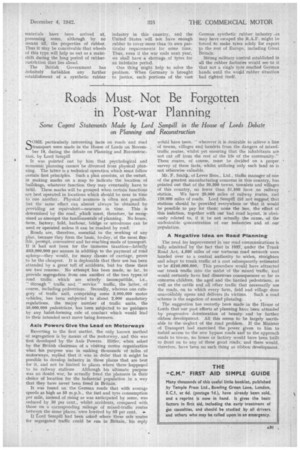Roads Must Not Be Forgotten
Page 33

If you've noticed an error in this article please click here to report it so we can fix it.
in Post-war Planning
Some Cogent Statements Made by Lord Sempill in the House of Lords Debate on Planning and Reconstruction SOME particularly interesting facts on roads and road transport were made in the House of Lords on November 19, during the debate on Plannieg and Reconstruction, by Lord Sempill It was pointed out by him that psychological and economic planning cannot be divorced from physical planning. The latter is a technical operation which must follow certain first principles. Such a plan consists, at the outset, in making marks on a map to indicate the location of buildings, whatever function they may eventually have to fulfil. These marks will be grouped when certain functions -are best operated in locations which should be near in time to one another. Physical nearness is often not possib/e. but the same effect can almost always be obtained by. providing an equivalent—nearness in time. This is determined by the road, ,which must, therefore, be recognized as amongst the fundamentals of planning. No house, farm, factory, field, harbour, bridge or aerodrome can be used or operated unless it can be reached by road.
Roads are, therefore, essential to the working of any plan, because they form the basis, to-day, of the most flex: ible, prompt, convenient and far-reaching mode of transport. If it had not been for the immense taxation—latterly £63,000,000 per annum in additiop to the payment of road upkeep—they would, for many classes of carriage, prove to be the cheapest. It is deplorable that their use has been attended by a great toll of accidents, but for these there are two reasons. No attempt has been made, so far, to provide segregation from one another of the two types of road traffic which are utterly incompatible, i.e.. " through " traffic and " service" traffic, the latter, of course, including pedestrians. Secondly, whereas one category of traffic unit, comprising some 3,000,000 motor vehicles, has been subjected to about 2,000 mandatory regulations, the major number of traffic units, the 30,000,000 pedestrians, 'has been subjected to no guidance by any habit-forming rule of conduct which would Teed to their intended next move being foreseen.
Axis Powers Give the Lead on Motorways
Reverting to the first matter, the only known method of segregation is by means of the motorway, and this was first developed by the Axis Powers. Hitler, when asked by the British chairman of a visiting motor organization what his purpose was in making thousands of miles of motorways, replied that it was in drder that it might be possible to develop industry in those places that are best for it, and not be limited to places where there happeeed to be railway stations Although his ultimate purpose was no doubt war, he actually freed the planners in their choice of location for the industrial population in a. way
that they have never been freed in Britain. •
It was found on the German roads that with average speeds as high as 55 m.p.h., the fuel and tyre consumption per mile, instead of rising as was anticipated by some, was reduced by 30 per cent., whilst accidents, compared with those on a corresponding mileage of mixed-traffic routes between the same places, were lowered by 83 per cent. ee. If Lord Sempill had been asked where these safe -routes for segregated traffic could be run in Britain,. his reply
wduld have been. " wherever it is desirable to relieve a line of towns, villages and hamlets from the dangers of mixedtraffic routes, whilst yet ensuring that the inhabitants are not cut off from the rest of the life of the community." These routes, of course, must be decided on a proper survey of these facts, whilst utilizing only such land as is not otherwise valuable.
Mr. F. Sraitla, of Lever Bros., Ltd„ traffic manager of one of the greatest manufacturing concerns in this country, has pointed out that of the 39,300 towns, townlets and villages of this country, no fewer than 31,500 have no railway station.. We have 20,000 miles of railway toutes, and 120,000 miles of roads. Lord Sempill did not suggest that stations should be provided everywhere or that it would be possible to pay for them; none the less, the effect of this isolation, together with our had road layout, is obviously related to, if it be not actually the cause, of the undesirable concentration of our industries and of our population.
A Negative Idea on Road Planning
The need for improvement in our road communications is fully admitted' by the fact that in 1937, under the Trunk Road Act, • 4,500 miles of our tortuous road network were handed over to a central authority to widen., straighten and adapt to trunk traffic at a cost subsequently estimated to be £240,000,000. This procedure would have attracted our trunk traffic into the midst of the mixed traffic, and would certainly have had disastrous consequences so far as concerns children, the aged and the harried pedestrians, as well as the cattle and all other traffic that necessarily use the roads, on to which every farm, field and village door unavoidably opens and delivers its victims. Such a road scheme is the negation of sound planning.
The suggestion has recently been made in the House of Lords that our past efforts at planning have been attended by progressive deterioration of beauty and by further ribbon development. All this seems to be largely ascribable to the neglect of the road problem. If the Minister of Transport had exercised the power given to him to forbid access to the new bypass roads and• to the approach roads to towns, no house or factory would have been built to front on to any of these great roads, and there would, therefore, have been no such thing as ribbon development.




















































